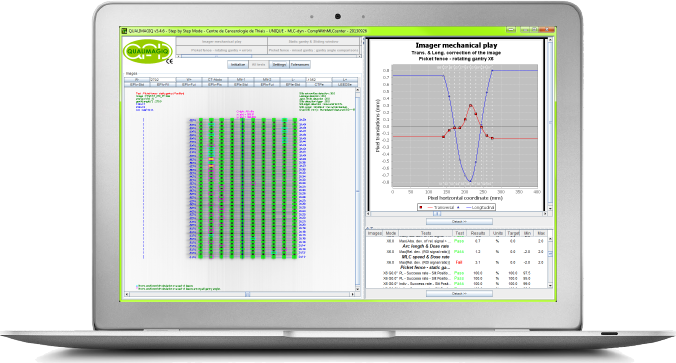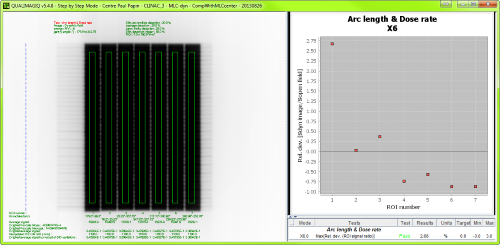Automates and Organises Quality Assurance in Radiation Therapy and Medical Imaging
MOD MLCdyn
QUALIMAGIQ module for a complete and fully automatic QA of the MLC used for IMRT or VMAT purposes

Connected to the QUALIMAGIQ platform, it takes only 2 mouse clicks for the MOD-MLC-dyn module to analyse the DICOM images acquired with the treatment machine’s high energy portal imager during quality control of a multi-leaf collimator (MLC) used specifically to modulate beam intensity during IMRT treatments, whether this modulation is obtained through a continuous (dynamic) movement of the MLC or through multiple static movements, and whether these movements are accompanied by a combined and continuous movement of the gantry or not
BY FAR THE BEST SOLUTION FOR RAPIDARC and VMAT QA!
This module automates the analysis of the following tests:
-
Pre-test N°1: advanced control of the sag of the high-energy portal imager and gantry flex when it is rotating. This pre-test is essential so that the subsequent tests really test the MLC. This pre-test also enables the MLC sagging to be accurately tested relative to the gantry angle. Thanks to the unique, particular characteristics of the OTP-ABACUS test object, it is possible to avoid this pre-test when you need to perform a very quick quality control including only the “Picket fence” tests (tests N°2 and N°3).
-
Test N°2: known as the “Sliding windows” test in which the precision of the continuous (dynamic) movement or of multiple static movements of the MLC for different fixed gantry angles is tested.
-
Test N°3: check of the position and width of the “Picket Fence” pattern created by several stops of the continuous (dynamic) movement or of its multiple static movements of the MLC for different fixed gantry rotation angles.
-
Test N°4: check during a continuous gantry rotation of the position and width of the “Picket Fence” pattern created by several stops of the continuous (dynamic) movement of the MLC during continuous rotation of the gantry.
-
Test N°5: same test as # 4 but with the introduction of voluntary errors in the dynamic movements and stops of the MLC.
-
Test N°6: a compound test drawn from tests #3 and #4 which compares the Picket Fence positions of a static versus a rotating gantry.
-
Test N°7: check the accuracy of the dose rate gating and of the gantry rotation speed during a partial or complete gantry rotation.
-
Test N°8: check of the accuracy of the dose rate gating and of the movement speed of the MLC leaves during a partial or complete gantry rotation.
-
Test N°9: global test, known as the "Snooker Cue" test, which searches for the position of the centre of different irradiation slits vis-à-vis the centre of one to five radio-opaque balls deliberately shifted laterally and vertically relative to the gantry rotation axis. In this test the gantry and the MLC move in a continuous (dynamic) manner and the MLC makes stops at the origins of the irradiation slits.


(*): Only tests N°1, 2, 3 and 8 can be performed with « dynamic » IMRT. In fact, tests N°4, 5, 6, 7 and 9 require a continuous rotation of the treatment machine’s gantry specific to the « VMAT » technique. Incidentally, a light version of the MOD-MLC-dyn module is also available. It handles only tests N°1, 2 and 3, which are the only tests which can be performed in the framework of « Step and Shoot » type IMRT for which beam intensity is modulated by means of multiple static movements of the MLC, static movements which are not accompanied by continuous gantry movement.
Specifications
The system is compatible with all types of multi-leaf collimators.
Less than 30 minutes is all the time you need to perform the entire control: installation of the test object, image acquisition and analysis, editing of 6 different PDF analysis reports and a trend curve for each tested parameter.
Associated test object:
- OTP-ABACUS from QUALIFORMED.
- For the "Snooker cue" test, 1 to 5 metallic balls set in lines along a relatively radio-transparent support will do.
Resources
You need a user manual? please contact us.
FAQ
Is it possible to realize in CINE mode the pretest which measures the EPID stray movements during the gantry rotation?
YES and it's also better because:
1- The pretest acquisition is performed strictly in the same condition than all tests which use it,
2- The gantry angular resolution of the pretest is increased,
3- And for you, it's faster to make the pretest acquisition in CINE mode.
For you, the pretest which measures the imager stray movement with the gantry rotation is crucial. Could you repeat us why?
YOU use the portal imager like a QA device. Of course it's a very nice idea for many reasons:
1- The device has a very good resolution and it is all the time available in front of the beam,
2- You win some acquisition time to use it for QA. So you save the money of your institution,
3 -You have a very effective maintenance contract on this device and not more expensive if you use the portal imager for QA,
4- QUALIMAGIQ analyses automatically EPID images!
But by cons WE have to take into account the eventual defects of the portal imager considering the performance that this device has to measure.
- For the MLCdyn tests, the tolerance on the picket fence slit positions and width is 0.2 to 0.5 mm. Unfortunately the lateral and longitudinal stray movements of the portal imager is 10 times this tolerance!
- Concerning the vertical stray movement of the EPID, it is not rare to have 5 mm. And 5 mm variation on the Source Imager Distance gives 1% variation on the signal. For all MLCdyn tests based on signal intensity measurements (MLC speed, gantry speed, sliding window tests) the tolerance is 2 % i.e. only 2 times more than the uncertainty when you don't take into account the SID variations.
Your brochure request has been added to your Download Cart.
At the end of your visit:
- Please click the "YOUR DOWNLOADS" button at the top right,
- Complete the form and SEND it.
You will get the documents shortly by email.






